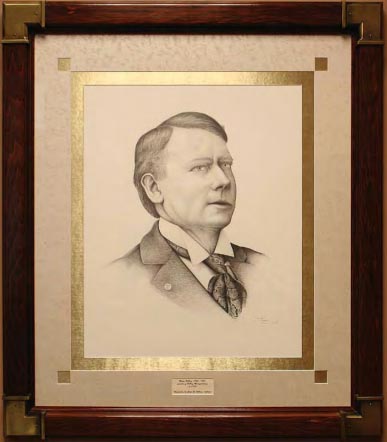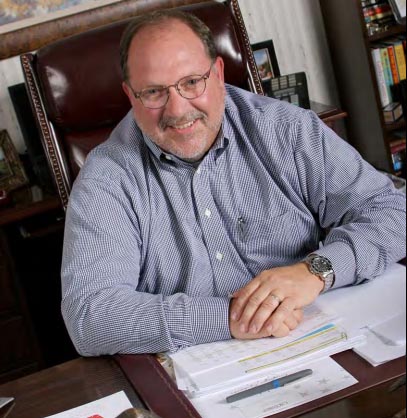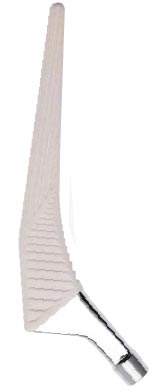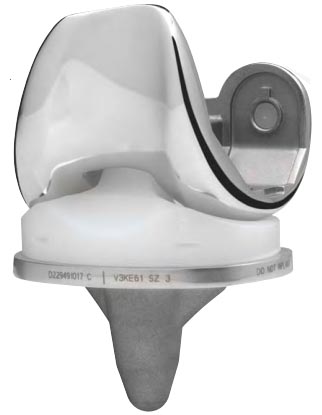by Jessica DuLong
Today’s Machining World Archive Volume 2 Issue 05

A timeline tracking the development of the orthopedics industry reads like the Book of Genesis: DePuy begat Zimmer. Zimmer begat OEC. OEC and Zimmer begat Biomet. And so on. Though today’s market for orthopedic equipment is global and growing, it seems all roads lead back to Warsaw, Indiana. Over the past century, a cluster of orthopedic equipment manufacturers has mushroomed up among the grain fields in the northeastern corner of the state, and today this small Midwest town is the orthopedic capital of the world. Tracing the industry’s history reveals how homegrown entrepreneurship and specialized local skills have led a series of small-town players to seize a spot in the global economy.
The financial services industry has its Wall Street, technology has Silicon Valley, but how did Warsaw, a town of 12,415 people, located 120 miles east of Chicago, come to be the world headquarters of orthopedics manufacturing?
If you squint a little, it’s not hard to picture a stage coach clip-clopping past the fat-faced, cornice-topped buildings that give downtown Warsaw its old-time feel. While you sit sipping a beer in Mad Anthony’s brew house, Center Street’s newest and hippest eating establishment, you can catch up on local history from a poster-sized reprint of a front-page news story from 1934. Apparently John Dillinger surprised a beat cop right on this corner in the wee hours of an April morning some 72 years ago. The notorious outlaw marched the officer, at gunpoint, to the police station to steal two revolvers and three bulletproof vests. Besieged by police and reporters in the aftermath of the “sensational raid,” the paper exclaimed, “Warsaw suddenly blossomed forth as a place of importance under the sun.” But anyone who knows anything about the history of orthopedics knows that by 1934, Warsaw’s significance had long-since been established—not by a bandit, but by a pharmaceuticals salesman named Revra DePuy.
Revra DePuy, Inventor and Pioneer
When Mr. DePuy first arrived to peddle his wares in 1894, Warsaw was a bustling market town and rail-road center. Oak-board sidewalks covered the muddy paths between downtown shops, and early wood-frame storefronts had been replaced by brick buildings, including the stylish Hotel Hays. But in doctors’ offices throughout the region, rudimentary medicine held sway. Fractures were all too common in farm country, and standard treatment protocols sometimes caused more harm than good. As the story goes, Mr. DePuy learned during sales calls that when physicians immobilized fractures with wood splints made from barrel staves, splinters often lodged under a patient’s skin and caused infection. Presented with this problem, the 32-year-old salesman dreamed up a solution that gave birth to commercial orthopedic manufacturing. He invented the fiber, and then the wire, splint.
So invested was Mr. DePuy in the promise of his idea that he set up shop in the Hotel Hays, choosing Warsaw as the best place to launch his new enterprise. What exactly appealed to him about the town remains a mystery. Perhaps it was the railroad; the area’s many lakes—over
100 in the region—or the newly opened Spring Fountain Park, which was quickly establishing itself as a major social center in northern Indiana.
Whatever the reason, Mr. DePuy’s choice put Warsaw on the map. More than a century after he sold his first splint, Warsaw is home to nearly two-thirds of the world’s market-share for orthopedic devices, held principally by Biomet, Zimmer Holdings, and DePuy Orthopedics, now a subsidiary of Johnson & Johnson. Other companies with a local presence include: Medtronic Sofamor Danek, Symmetry Othy, Paragon Medical, and other small suppliers. These companies design and manufacture reconstructive orthopedic implants, including joint, dental, and spinal implants, trauma products and related surgical instruments. If you or someone you know has an artificial knee or hip, there’s a good chance you can trace it back to Warsaw.
Today, orthopedics manufacturing employs about 3,500 workers in Kosciuscko County, or nearly 12 % of the labor force. Last year, Zimmer achieved $3.29 billion in net sales, and Biomet reported revenues of $2 billion. (Johnson & Johnson does not report DePuy’s earnings separately.) The orthopedic cluster is largely responsible for Warsaw’s prosperity, according to a 2001 report commissioned by the Indiana Health Industry Forum, which notes that high wages falter through the entire local economy. Clearly, it was orthopedics manufacturing (not robbery) that actually earned Warsaw its place under the sun.

Is it something in the water?
Why Warsaw? That question evokes as many responses as there are respondents. Some attribute Warsaw’s success to an indefatigable Midwestern work ethic. Others say it’s simply a matter of “right place, right time.” But certainly, intrepid entrepreneurship is a thread that runs through the industry’s hundred-plus-year history.
“God packages people certain ways. Some people are packaged as entrepreneurs, and some people aren’t.” When he speaks, there’s no question Toby Buck is clear which category he falls into. His booming voice creates a curious counterpoint to the image of a commander in battle portrayed in the painting on the wall behind him. Buck’s blue, collared shirt crests over an ample belly, bordered by a pair of “good Republican suspenders” that depict men wielding signs calling for tax cuts. He calls Warsaw an “entrepreneurial incubator” and says when he set out to penetrate the orthopedic supply market; there was no question this was the place to be. “Warsaw is probably the greatest economic cluster in the smallest number of square miles in the world.”
Founded in 1991, Buck’s company, Paragon Medical, is a relatively young upstart in the centenarian world of Warsaw orthopedics—perhaps proof that entrepreneurship still rules the day. Early on, Paragon cut its teeth with a menagerie of polymer products from shipping pallets and playground slides to outhouses. But orthopedics was always the goal. Next, the company designed and manufactured surgical instrument sterilization cases and trays, which Buck calls “glorified tackle boxes for surgeons.” Then, once the company had established enough of a track record as an orthopedic supplier, its engineers branched out into instrumentation and implantable devices. Today’s product line includes hip, knee, spine, sports medicine, trauma, and cardiovascular applications, as well as dental implants, which are sold to Zimmer and DePuy, among others. But as Buck will tell you, orthopedics is no easy nut to crack. “It’s difficult to break in as a supplier. The orthopedics community is like a fraternity. The industry is very close knit, very cross-pollinated. It’s like a brotherhood.”
The seeds for that “cross-pollinated” brotherhood were planted by Mr. DePuy, who was intent on bringing his invention to market. He had no way of knowing then that though he’d remain childless (biologically), the progeny of his fledgling company would mold the future of orthopedics for generations to come.
Mr. DePuy made his first splints after his own image, molding the devices on his own limbs. Through the late 1890s, he did all the manufacturing himself and sold sets to two salesmen who peddled them regionally. Soon, orders began to outpace supplies, and he couldn’t keep up. Then, on a fateful day in June of 1905, Mr. DePuy hired a 20-year-old Western Union telegraph trainee named Justin O. Zimmer, who started making splints the following day. “Mr. DePuy and I made a sufficient number of splints during the greater part of that summer to take care of all orders,” recalled Mr. Zimmer in his autobiography. Before long, Mr. Zimmer started selling splints, too. By 1919, the company had 16 employees on the payroll, which was deemed one of the important assets of the community. When Mr. DePuy died of heart trouble in 1921, he was remembered as a prominent businessman with many friends.
After Mr. DePuy’s death, Mr. Zimmer continued as national sales manager for a time. But an idea had been brewing, and in 1926 he approached Mr. DePuy’s widow with his concept for an aluminum splint and asked to buy an interest in the company. She refused. He was angry—and determined. So the next year, contrary to the advice of his wife and his parents, Mr. Zimmer went into business for himself, taking two coworkers with him. In the decades that followed, many more in the industry would catch the same entrepreneurial spirit and branch out on their own.
By early 1927, the basement of the Zimmer family house at Winona Avenue and Indiana Street was over-run with machinery. Mr. Zimmer and his small staff were busy preparing a display of samples to present at the American Medical Association meeting in Washington, D.C. Soon a catalog of 50 aluminum splints was available for the nine-person sales force. During the first seven months of operation, the new company outdid DePuy, boasting sales of $160,000. Mr. Zimmer and his crew delighted in proving wrong all those who’d predicted that demand for splints could not support two companies, and one or both would fail. The market was growing, not shrinking. By 1942, Zimmer’s annual sales topped $1 million.
Inspired by new technologies and potential profits, a number of DePuy and Zimmer employees launched their own businesses in subsequent years. Perhaps the most significant were the founders of Biomet, a pair of ex-Zimmer employees who joined forces with two employees from another Zimmer offshoot called Orthopedic Equipment Company (OEC), based in Bourbon, Indiana. The four—Dane Miller, Niles Noblitt, Jerry Ferguson and Ray Harroff branched out on their own in 1977, just after new stringent FDA regulations sent shockwaves through the orthopedics industry. Skeptics figured the barriers to entry for the newcomer would be insurmountable. Instead, the founders simply built the company around the new rules, actually benefiting from the disruption the FDA caused at their established competitors. In fact, by 1984, the company had grown enough to acquire its progenitor, OEC. And in 1992, Business Week ranked Biomet number 316 in its “Top 1,000” companies and named CEO Miller the top executive in terms of return to shareholders relative to compensation.
Often cited as a classic American business success story, Biomet has grown from its modest beginnings (in a converted barn with a gutted mobile home attached) to an orthopedics world leader, reporting $2 billion in revenue for fiscal 2005.
Recently, however, investors, analysts and Biomet employees were surprised when Miller, who had served as the company’s top executive for over 30 years, announced his retirement in March.
Rumors that the company, which recently hired Morgan Stanley to help it explore strategic alternatives, have raised questions about Biomet’s future. But the company’s market value, estimated at $9 billion, demonstrates how far Biomet has come. Warsaw’s development as the orthopedic world leader has resulted from this kind of entrepreneurial spirit and from the depth of industry wisdom in the region.
Tribal knowledge

It seems like everyone you talk to in Warsaw knows something about orthopedics. The industry is enmeshed in the fabric of daily life in ways that are sometimes difficult for residents to quantify or explain. Everyone knows someone in the industry. An institutional memory extends community-wide. One of the greatest surgical advances of the twentieth century was the development of the total joint replacement. The first artificial hip was invented in the early 1960s, and the first mobile-bearing total knee replacement was designed in 1977. Today more than 450,000 Americans undergo total knee replacement surgery each year, and companies like DePuy, Zimmer and Biomet compete to get surgeons to recommend their devices to patients. Each year, they showcase their products at the annual meeting of the American Academy of Orthopedic Surgery (AAOS), where they educate surgeons about their latest advancements in design and materials.
Traditionally, implants have been made with hard metal components, but researchers are constantly developing new materials, including ceramics, hydro gels and woven metals with improved tensile strength, flexibility and durability. As new materials are found to be successful, it’s often a race to the FDA to get approval. The same is true for design advancements. For example, DePuy is the only manufacturer with FDA approval to market a rotating platform knee in the United States.
The company’s latest release is the P.F.C. Sigma RP-F knee that allows knee replacement patients to sit cross-legged or perform deep knee bends. For its part, Zimmer has recently focused on its growing portfolio of minimally invasive technologies, including muscle-sparing surgical techniques and instruments. Last year, the company was first to market a knee component that can be assembled within the patient, called the NexGen MIS Tibial Plate.
Unlike the components in automobile or aerospace manufacturing, the parts produced at Zimmer, DePuy, Biomet and other companies end up in a patient’s body. Meticulous quality control standards are imperative. And though the plants in Warsaw look, in many ways, like machine shops anywhere, the integrity of materials and ft of these products have a very intimate impact on each patient. A bone screw is not just any screw, and surgeons understand that stringent quality assurances can contribute to higher prices. They recognize that sometimes you do get what you pay for. “I’ve had Brand X sell me a screw for $85 while Brand Z offers it for $17,” says Dr. James Hamilton, an orthopedic surgeon, professor and chairman of the University of Missouri, Kansas City School of Medicine and a spokesperson for the AAOS. “I know Brand X’s screw is priced higher because of the quality controls that go into making it. When it comes to reliability and durability, is the extra cost worth it? In some items, believe me, it is.” Hamilton says the commercial orthopedics industry has benefited from a resident workforce in Warsaw that knows this business.
“Highly skilled machinists are needed to do this work and geography has allowed more rapid expansion of technology than would otherwise be possible,” he explains. Even though orthopedics has gotten highly sophisticated and technological, there is an element of craftsmanship involved, explains Brad Bishop, director of public affairs for Zimmer.

Nothing reveals this fact better than watching a surgeon use a specialized bone saw to cut away diseased tissue from a sedated patient’s knee. Once the cut is made, there’s no going back, and it’s vital that the artificial knee implant fit precisely. “You’re taking an unnatural object and fitting it to human anatomy,” Bishop explains. “There’s a certain level of customization, even with standard parts, which requires very specific design and innovation.” The resident talent in Warsaw, developing generation after generation, has played a crucial role in innovation.
While high-tech engineering positions at these companies continue to be fled largely by graduates from nearby universities, smaller, local institutions are determined to feed the orthopedic industry their own, home-grown talent. Two years ago, Grace College launched the Orthopedic Scholar Initiative, which program coordinator Michael Harstine envisions as providing a “human capital supply chain” for the professional side of the industry. The program, which includes internships with local companies, aims to “position our graduates as the industry’s preferred employees because their academic experiences were formed by the industry leaders themselves,” Harstine explains.
Meanwhile, Ivy Tech Community College prepares students for employment on the production side. The college’s manufacturing skills program, designed with input from industry representatives, trains entry-level CNC machinists. Classes taught by adjunct faculty, who work in local orthopedic plants, offer students hands-on experiences that reflect real-world job situations they might encounter, perhaps at the DePuy plant, which happens to be right next door.
Each new orthopedic enterprise founded in Warsaw has reaped the benefits of the industry wisdom that has evolved here. Paragon is no exception. “There is a peculiar knowledge base in the orthopedics industry that has been cross-pollinated over a hundred years,” Buck explains. “Think of the amount of tribal knowledge that must exist here in this geographic area.” He credits this knowledge as a key factor in his company’s success. After all, when Buck went looking to fall his company’s vacant CFO seat, he didn’t have to go far. He hired Debra Yingling, former worldwide finance director at DePuy, whom he also happened to know through church. “I didn’t have to bring somebody from outside the Midwest here to fall the job,” recounts Buck. “I found probably one of the most superbly qualified candidates in the world right here.”
Neighborly Competition
Business analysts are quick to tell us that in a global economy it no longer matters whether you do business in Dubuque or Dubai. If that’s true, could there be any advantage for DePuy, Zimmer, Biomet, and many of their suppliers to be neighbors? Drawing from a common, highly skilled, industry-specific talent pool seems to be one benefit. Another seems to be the way proximity fosters relationships.
Take it from the new guy on the block, who chose this location strategically. “It’s all about relationships,” says Buck. “And it’s much easier to build relationships when you’re located right next to a client cluster. If you were a Zimmer or a DePuy, wouldn’t you want a dominant supplier that offered a comprehensive portfolio of solutions right next door?” With all the talk of how technology mitigates geography, Buck recognizes that his location allows him to “have eye contact during working sessions right here, right now, within 10 minutes if I need to.”
Video conferencing is all well and good, but sometimes an in-person conversation makes all the difference. But what happens when you’re not just near your clients, but also your competitors? It seems small-town neighborliness, even between members of competing organizations, is the norm. “My next-door neighbor is a DePuy development engineer,” explains Zimmer’s Bishop. “We go to the same church. Our kids play together. Our rule is, when it comes to business, the less said, the better. You can talk about what your kids are doing in school, but you shouldn’t talk about what’s going on at work.”
Over the years, Warsaw residents have mastered a chummy rivalry between competing companies, on par with that between school sports teams. It helps that for the most part, the competition doesn’t play out in War-saw. Instead, it happens at conferences and in hospitals where surgeons choose what equipment they install. What also helps is the shared mission. “When it comes right down to it, we’re all about patient care,” says Mary Beth Sellers, a DePuy employee for 15 years. “There’s plenty of market out there for everybody. Here in this community, we all get along very well.”

3 Comments
Excellent article! Very interesting!
Great article. A nice little 5 minute Orthopaedic Industry history lesson!
This was such a good article!! – I’m wondering where Stryker fits in to this story – where they an off-shoot company off of Zimmer?